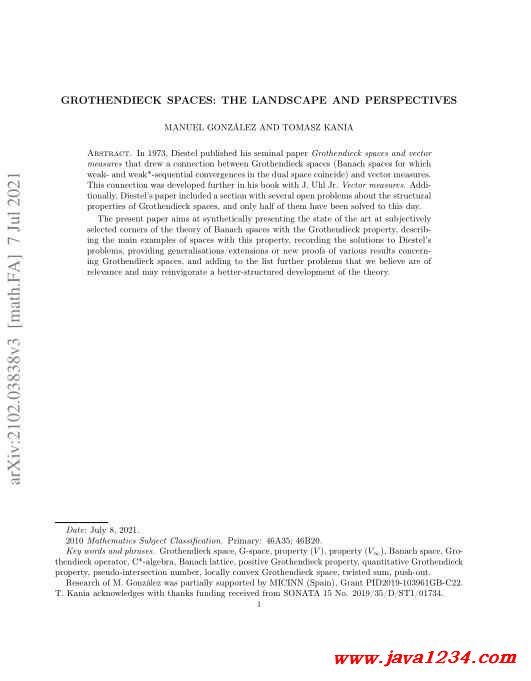| 失效链接处理 |
|
Grothendieck Spaces The Landscape and Perspectives PDF 下载
本站整理下载:
相关截图:

主要内容:
2.1. L p -spaces and related concepts
Let 1 6 λ < ∞ and 1 6 p 6 ∞. A Banach space X is a L p,λ -space whenever every
finite-dimensional subspace F of X is contained in another finite-dimensional space G of
X whose Banach–Mazur distance to ‘ dimG
p
is at most λ. A Banach space X is said to be a
L p -space if it is a L p,λ -space for some λ. We will be primarily interested in the L ∞ -spaces
and the L 1 -spaces. A Banach space X is a Lindenstrauss space, whenever it is a L ∞,λ -space
for every λ > 1; equivalently, if X is an isometric predual of some L 1 (µ)-space. Spaces of
the form C 0 (K) for some locally compact space K are natural examples of Lindenstrauss
spaces.
We say that a Banach space X is a
g
OL ∞,λ -space whenever every finite-dimensional
subspace of X is contained in another finite-dimensional subspace whose Banach–Mazur
distance to some finite-dimensional C ∗ -algebra is at most λ. The g OL ∞ -spaces are the space
which are
g
OL λ,∞ -spaces for some λ > 1.
The just-introduced terminology concerning
g
OL ∞ -spaces is not standard as the non-
commutative analogues of L ∞,λ -spaces—usually termed OL ∞,λ -spaces—are defined in terms
of the completely bounded Banach–Mazur distance to the set of finite-dimensional C ∗ -
algebras. OL ∞,λ are
g
OL ∞,λ -spaces. A C ∗ -algebra is nuclear if and only if it is OL ∞,λ for
some λ > 6 ([83, Theorem 1.2]). We refer to [83] for additional information and a more
precise definition of these spaces.
2.2. Direct sums and ultraproducts
Let Γ be a (possibly uncountable) set and let E be a Banach space that has a normalised,
1-unconditional basis (e γ ) γ∈Γ . Given a collection (X γ ) γ∈Γ of Banach spaces, the E-sum of
(X γ ) γ∈Γ , denoted by ( L γ∈Γ X γ ) E , is the set of all tuples (x γ ) γ∈Γ with x γ ∈ X γ for each
6 M. GONZÁLEZ AND T. KANIA
γ ∈ Γ, and such that
P
γ∈Γ kx γ ke γ
∈ E. Formally, the E-sum depends on the choice of the
basis but when the basis is clear from the context we can afford this abuse of notation.
If the basis (e γ ) γ∈Γ is shrinking, the coordinate functionals (e ∗
γ ) γ∈Γ
associated to that
basis form a normalised, 1-unconditional basis of E ∗ . In this case, the map
Λ E : (
M
γ∈Γ
X ∗
γ ) E ∗
→
?
(
M
γ∈Γ
X γ ) E
? ∗
given by
? (x
γ ) γ∈Γ ,Λ E (f γ ) γ∈Γ
?
=
X
γ∈Γ
hx γ ,f γ i
for (x γ ) γ∈Γ ∈ ( L γ∈Γ X γ ) E and (f γ ) γ∈Γ ∈ ( L γ∈Γ X ∗
γ ) E ∗ , is an isometric isomorphism (see
[104, Section 4] for details). When the basis (e γ ) γ∈Γ is additionally boundedly complete
(which implies that E is reflexive), the bidual of ( L γ∈Γ X γ ) E is naturally isometrically
isomorphic to ( L γ∈Γ X ∗∗
γ
) E .
Let Γ be an infinite set and let {X γ : γ ∈ Γ} be a family of Banach spaces. The ‘ ∞ -sum
of (X γ ) γ∈Γ , denoted ( L γ∈Γ X γ ) ‘ ∞ (Γ) , is the set of all tuples (x γ ) i∈Γ such that x γ ∈ X γ
(γ ∈ Γ) and k(x γ ) γ∈Γ k ‘ ∞ (Γ) = sup γ∈Γ kx γ k < ∞; it is a Banach space with respect to this
norm. When X γ = Z for each γ ∈ Γ, we write X = ‘ ∞ (Γ,Z).
Let U be a non-trivial ultrafilter on Γ (assuming that Γ is infinite). Then
N U ? (X γ ) γ∈Γ ? =
? (x
γ ) γ∈Γ ∈ E: lim
γ→U
kx γ k = 0 ?
is a closed subspace of X := ( L γ∈Γ X γ ) E . The ultraproduct of {X γ : γ ∈ Γ} along U,
denoted [X γ ] U , is defined as the quotient space X/N U ((X γ ) γ∈Γ ); when X γ = Z for all
γ ∈ Γ, then we call the quotient space an ultrapower of Z (along U).
2.3. Ordered normed spaces
Let E be a normed space. A convex subset P ⊂ E is a cone, whenever λP = P for
all λ > 0 and P ∩ (−P) = {0}. An ordered normed space is a normed space E with a
distinguished cone P; we will denote by (E,P) an ordered normed space or simply by E
if the choice of the cone is clear from the context.
For x,y ∈ E we write x 6 y as long as y − x ∈ P. If there exists a number λ > 0
such that whenever 0 6 x 6 y (x,y ∈ E) we have kxk 6 λkyk, the cone P is called
normal. An order unit of (E,P) is an element e ∈ P such that for every x ∈ P there
is some n ∈ N with x 6 n · e. A convex subset B of P is called a base for P, whenever
for each non-zero x ∈ P there is a unique real number f(x) > 0 such that f(x) −1 x ∈ B.
A cone P is well-based in X if it has a bounded base B defined by a some f ∈ X ∗ , that
is, B = {x ∈ P : hf,xi = 1}. An element x ∈ P is a quasi-interior point of P, when the
order interval [0,x] = {z ∈ E: 0 6 z 6 x} is linearly dense in X. Whenever E is a Banach
lattice or a C ∗ -algebra, by default we consider the (canonical) positive cone E + therein.
Definition 2.3.1. Let (E,P) be an ordered normed space.
|




 苏公网安备 32061202001004号
苏公网安备 32061202001004号



